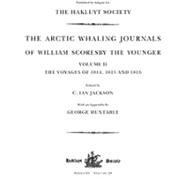The Arctic Whaling Journals of William Scoresby the Younger/ Volume II / The Voyages of 1814, 1815 and 1816
, by Jackson,C. Ian- ISBN: 9780904180923 | 0904180921
- Cover: Hardcover
- Copyright: 12/28/2008
This second volume of William Scoresby's journals contains the unpublished accounts of his three voyages in the Esk in 1814-16. As before, these lengthy journals combine scientific records and social and religious comment as well as detailed descriptions of navigation and whaling. They also continue to demonstrate the competence and confidence of Scoresby which were evident from the moment he assumed command of the Resolution in 1811. However, each of the journals also shows the dangers inherent in what might otherwise seem to be routine annual sailings to the Greenland Sea in latitudes 78° to 80° N. The dangers were not merely those of besetment and damage by the ice where the bowhead whales had to be sought, nor of the persistent fog and frequent gales characteristic of these icy seas; human error and even stupidity could be equally disastrous. In 1814, the Esk was caught in the tidal current of the Sumburgh Röst and nearly wrecked before she even reached Shetland on her outward voyage. The journal for 1815 also contains a graphic description of the destruction by fire of the Hull whaler Clapham, regarded by Scoresby as 'the finest ship that ever engaged in the [whale] fishing trade.'For high drama, and Scoresby's crisis management and seamanship, however, the 1816 journal is outstanding. When part of the Esk's hull was torn off by ice in latitude 78° N on 29 June, various methods of repair were tried without success, including a drastic attempt to invert the empty ship in the sea at the ice-edge. Scoresby's ability to return the Esk safely to Whitby on 26 July, with only the floorboards of the hold keeping the leakage to a manageable rate, still seems as incredible now as it was to the crews of the other whaling ships who had eagerly anticipated plundering an abandoned ship in the Arctic.In addition to the journals and the editor's introduction, this volume also contains a unique 'second view' of the 1814 voyage: the journal kept by a young supernumerary, Charles Steward, and an appendix by George Huxtable, FRIN, on Scoresby's navigation methods.






